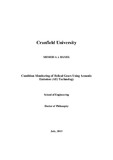JavaScript is disabled for your browser. Some features of this site may not work without it.
| dc.contributor.advisor | Mba, David | |
| dc.contributor.advisor | Addali, Abdulmajid | |
| dc.contributor.author | Hamel, Mhmod A. A. | |
| dc.date.accessioned | 2014-06-23T13:05:24Z | |
| dc.date.available | 2014-06-23T13:05:24Z | |
| dc.date.issued | 2013-07 | |
| dc.identifier.uri | http://dspace.lib.cranfield.ac.uk/handle/1826/8561 | |
| dc.description.abstract | Techniques such as vibration monitoring, thermal analysis and oil analysis are well established as means to have been used to improve reliability of gearboxes and extend time-to-failure. In this area Acoustic Emission (AE) technology is still in its infancy but the attention shown by researchers towards this method has increased dramatically because several studies have shown the AE offers the important advantage of improved sensitivity over more conventional monitoring tools for the early detection and prediction of gear failure. Helical gear lubrication is critically important for maintaining the integrity of operating gears and the oil also prevents asperity contact at the gear mesh thereby protecting the gears from a deterioration process and surface failures. In gear systems, there are three types of lubrication regimes: Dry Running, Boundary Lubrication (BL), Hydrodynamic Lubrication (HL) and Elastohydro-dynamic Lubrication (EHL). The last regime is associated with the normal operating running condition of gears. Acoustic emissions were acquired from gears and analysed for different lubrication regimes (dry, BL, HL and EHL regimes at different temperatures), and corresponding specific film thicknesses (λ) levels. The results showed an inverse relationship between AE signal levels and specific film thickness (λ) of the oil. This relation was used to determine the lubrication regime from the measured AE signals. For instance, dry running had the highest AE levels which were attributed to the metal-to-metal contact of the gear mesh. The BL regime had relatively high AE levels which also attributed to the level of asperity contact is greater than the oil film thickness. The HL regime was characterized by the lowest AE levels due to the lubricant oil completely separating the teeth during gear meshing. Finally, the EHL regime showed intermediate AE levels compared to the BL and HL regimes because the oil film was less than for the HL regime but greater than for the BL regime. It is shown that the application of advanced signal processing methods is necessary for monitoring helical gears; Kurtosis and Spectral Kurtosis were used to investigate the AE signatures and found to be effective in de-noising (spectral kurtosis) acquired signals. Acoustic Emission proved to be a powerful tool to detect the oil regime for both defective and non-defective conditions. It is concluded that the experimental findings of this research programme will provide the foundations for significant advancement in the application of AE for the determining the lubrication regime present within a helical gearbox and for the detection of developing gear faults. This should give a new impetus in the field of maintenance and prevention of human and material catastrophes. Several papers presenting the findings of this research have been published in international journals and given at conferences. | en_UK |
| dc.language.iso | en | en_UK |
| dc.publisher | Cranfield University | en_UK |
| dc.rights | © Cranfield University, 2013. All rights reserved. No part of this publication may be reproduced without the written permission of the copyright holder | en_UK |
| dc.title | Condition Monitoring of Helical Gears Using Acoustic Emission (AE) Technology | en_UK |
| dc.type | Thesis or dissertation | en_UK |
| dc.type.qualificationlevel | Doctoral | en_UK |
| dc.type.qualificationname | PhD | en_UK |
